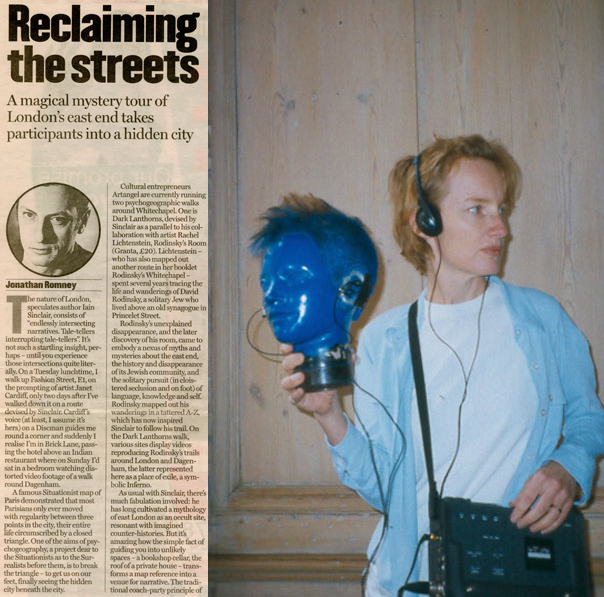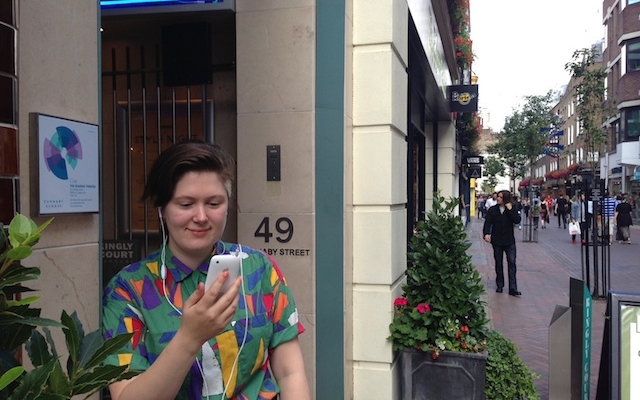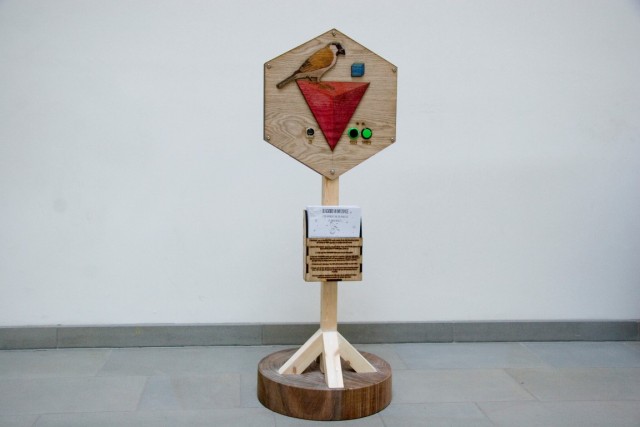Following the success of our recent Carnaby Echoes commission by Lucy Harrison, we’ve been thinking about other examples of artists embedding audio into the public realm and the ways in which newtechnologies have enabled a direct interaction between place and sound.

In 1999 Artangel launched Janet Cardiff’s seminal project The Missing Voice in which a fictional narrative unfolds as visitors walked a specific route around London’s East End.
To participate in this acclaimed audio journey, audiences had to collect a Discman and headphones from the Whitechapel library. With our 2013 eyes, this process of collecting hardware to encounter content via a fixed media seems fairly archaic. These days it is possible to encounter content directly with mobile apps and smart phone technology.
GPS tracking technology has created opportunities for artists to embed content into specific locations in the public realm. For instance, MISSORTS, a recent project in Bristol developed by Situations, features stories by ten writers and a newly composed soundtrack fed directly to your smartphone as you move around the city. This permanent public artwork was created by writer Tony White and is now described as an ‘urban soundwalk’.

Missorts and Carnaby Echoes were both programmed in collaboration with Calvium who pioneered the Soundwalk Platform, a flexible software package that places audio content in specific geographic locations. In the case of Carnaby Echoes, 15 numbered plaques are permanently installed in relevant buildings to mark key historical locations in Carnaby Village. As audiences move around the area, music relating to specific clubs, magazine offices or shops is triggered. When users encounter plaques, they can activate the map to hear audio interviews and archival material relating to the specific locations as well as access a series of 13 short films about the locations. Spanning 100 years of history, the Soundwalk Platform allowed artist Lucy Harrison to bring history to life through interactive audio. This interface engages audiences in a direct and personal encounter with people and place.

Blackbird in Infospace is another example of embedded audio in public developed this summer by Juneau Projects and in collaboration with experimental gallery Movement in Worcester. Juneau Projects, artist duo Ben Sadler and Philip Duckworth, have been working together since 2001. Their practice spans collaborative installations, animation, sculpture, sound and performance. Following the launch of a new EP of songs, Juneau Projects worked with Movement to disperse the tracks around the city of Worcester by creating five USB download points (much like the now popular ‘Dead Drops’).The points were located throughout the city, forming a trail that visitors followed to download all five piece of music created for the project.
What these projects share is the goal of providing audiences with the impetus to move and experience the public realm through sound. Now that digital content is at our fingertips, the connection between place and content is made in the blink of an eye. Opportunities to activate the public space through embedded audio are likely to expand, creating exciting new opportunities for artists to convey content and audiences to engage with place.
The Carnaby echoes app can be downloaded from the App Store or via Google play, or via www.carnabyechoes.com
Written by Sarah Carrington

The Rise of Embedded Audio Art
7/11/2013
Following the success of our recent Carnaby Echoes commission by Lucy Harrison, we’ve been thinking about other examples of artists embedding audio into the public realm and the ways in which newtechnologies have enabled a direct interaction between place and sound.
In 1999 Artangel launched Janet Cardiff’s seminal project The Missing Voice in which a fictional narrative unfolds as visitors walked a specific route around London’s East End.
To participate in this acclaimed audio journey, audiences had to collect a Discman and headphones from the Whitechapel library. With our 2013 eyes, this process of collecting hardware to encounter content via a fixed media seems fairly archaic. These days it is possible to encounter content directly with mobile apps and smart phone technology.
GPS tracking technology has created opportunities for artists to embed content into specific locations in the public realm. For instance, MISSORTS, a recent project in Bristol developed by Situations, features stories by ten writers and a newly composed soundtrack fed directly to your smartphone as you move around the city. This permanent public artwork was created by writer Tony White and is now described as an ‘urban soundwalk’.
Missorts and Carnaby Echoes were both programmed in collaboration with Calvium who pioneered the Soundwalk Platform, a flexible software package that places audio content in specific geographic locations. In the case of Carnaby Echoes, 15 numbered plaques are permanently installed in relevant buildings to mark key historical locations in Carnaby Village. As audiences move around the area, music relating to specific clubs, magazine offices or shops is triggered. When users encounter plaques, they can activate the map to hear audio interviews and archival material relating to the specific locations as well as access a series of 13 short films about the locations. Spanning 100 years of history, the Soundwalk Platform allowed artist Lucy Harrison to bring history to life through interactive audio. This interface engages audiences in a direct and personal encounter with people and place.
Blackbird in Infospace is another example of embedded audio in public developed this summer by Juneau Projects and in collaboration with experimental gallery Movement in Worcester. Juneau Projects, artist duo Ben Sadler and Philip Duckworth, have been working together since 2001. Their practice spans collaborative installations, animation, sculpture, sound and performance. Following the launch of a new EP of songs, Juneau Projects worked with Movement to disperse the tracks around the city of Worcester by creating five USB download points (much like the now popular ‘Dead Drops’).The points were located throughout the city, forming a trail that visitors followed to download all five piece of music created for the project.
What these projects share is the goal of providing audiences with the impetus to move and experience the public realm through sound. Now that digital content is at our fingertips, the connection between place and content is made in the blink of an eye. Opportunities to activate the public space through embedded audio are likely to expand, creating exciting new opportunities for artists to convey content and audiences to engage with place.
The Carnaby echoes app can be downloaded from the App Store or via Google play, or via www.carnabyechoes.com
Written by Sarah Carrington